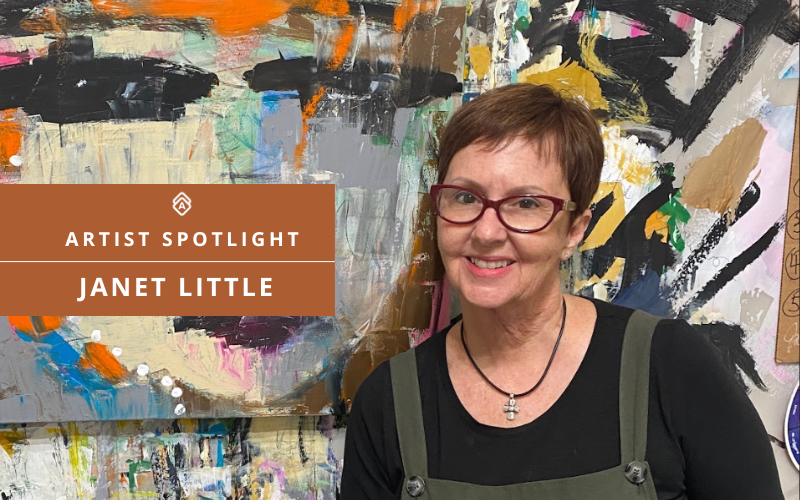
"I paint women expressing strength, trust, resolve and sadness. I always say my ladies say things we may not be able to speak out loud ourselves.”
There’s something about Janet Little’s work that feels like a deep exhale—like finally putting emotions into form.
As a self-taught artist, Artwork Archive's Featured Artist turned to painting after a life-changing diagnosis of Stage 4 ovarian cancer. "I know the discovery of making art has saved me as I fought ovarian cancer reoccurrences two more times in the past 12 years. Now, I can’t imagine not painting," she shares.
A former nurse-midwife, she’s always been surrounded by powerful women—through birth and healing, grief and grit. That presence echoes in her expressive, emotionally rich portraits.
She paints fast. She paints intuitively. And in each one of Little's bold acrylic portraits, you'll find figures of women meant to connect—through the rawness of shared human experience.
Artwork Archive had the chance to chat with Janet Little about how she found her artistic path, the inspiration behind her work, and how Artwork Archive is her go-to tool.
You can see more of her work on Discovery and learn more about her art practice below:
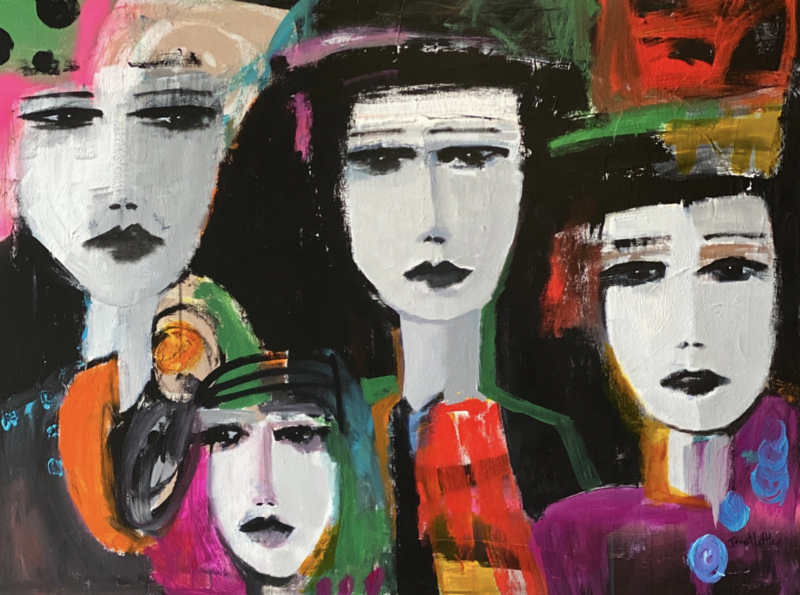
Janet Little, Millie's Calm Confidence, 30 x 40 x 1.5 in
How Janet Little Approaches a Painting
There’s no blueprint or checklist when Janet Little begins a painting. Her approach is fluid, explorative, and guided by instinct.
“I paint very intuitively with no real plan when I start,” Little shared.
She usually begins in one of two ways. “One way is I place layers of color first. Then I begin to develop the piece where I think the face would make the best impact. Sometimes I start with making the dark areas for the facial features and then work from there.”
As the work begins to take shape and a face emerges, design elements start to follow—like the signature white dots that appear along the neck and side of the face in many of her pieces. “Sometimes I write words that I am feeling as I paint to express what the piece is trying to say.”
Her favorite part? “When I'm beginning the piece and I have complete freedom with my strokes and color placement. I don’t think, I just do.”
The Turning Point That Brought Painting into Her Life
This artist didn’t grow up painting. In fact, she didn’t start until after receiving a Stage 4 ovarian cancer diagnosis. Before that, she spent years as a nurse-midwife—helping women through some of life’s most powerful and vulnerable moments.
“I was privileged to witness women facing birth and other phases of their lives that took strength and trust,” she said. “Then when I was fighting cancer at the age of 58, I saw that same strength and trust in the women I met in the chemo lounge.”
During her first remission, a friend invited her to join a small community art class. “I agreed, even though I had never considered art in my life.”
Today, her paintings often feature women who embody strength, trust, and resolve. “I always say my ladies say things we may not be able to speak out loud ourselves.”
In the 12 years since her diagnosis, Little has faced cancer recurrences twice more—and painting has been a lifeline. “I know the discovery of making art has saved me. Now, I can’t imagine not painting. I have made so many wonderful connections with the women who have resonated with and purchased my art.”
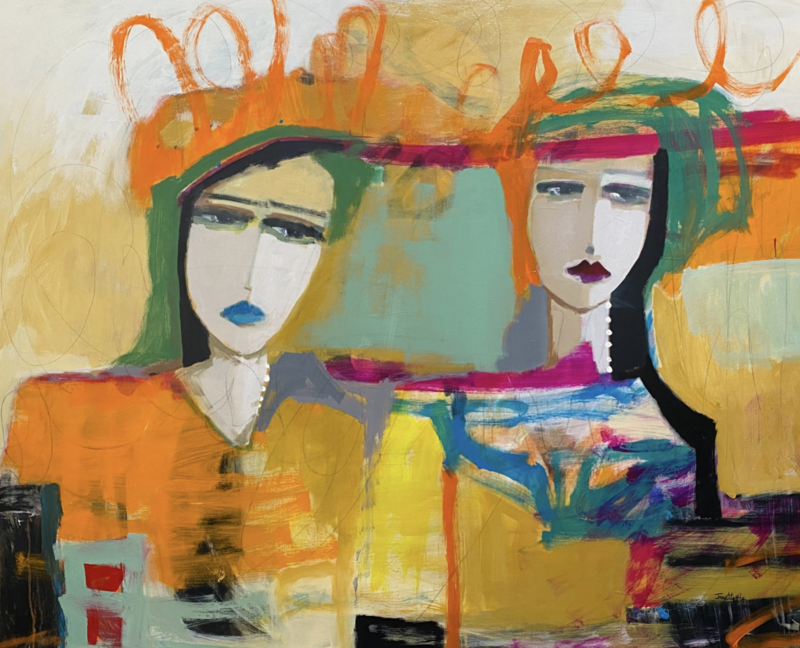
Janet Little, Connection: What I Think You Think, 48 x 60 x 1.5 in
The Women Who Inspire Her the Most
Janet Little's work is deeply inspired by the strength of women—and her life has given her a front row seat to witness that power.
“Being a nurse-midwife, I've looked into the eyes of so many young women as they faced one of the most difficult and unknown experiences of their lives—birthing their baby. In those moments, even as they were fearful and in disbelief of what lay ahead, they trusted my voice and my calm but stern presence. They knew they could do it. That, to me, is women empowerment for sure.”
She also recalls the moments where strength looked like grief. “There were several times when I was called to be with moms when they had a profound loss at term and needed to initiate and complete the birthing process. I witnessed so much resolve and determination to complete their task. You can’t put into words the depth of emotion you feel watching that kind of strength and sadness.”
And later in life, during her time in the chemo lounge, Little found that kind of resilience in community too. “We all lifted each other up. Whether it was a kind smile, a reassuring story, or just a quick laugh. Women need other women to confide in, to laugh with, and to tell their story to. We can mirror back to each other our understanding and our shared emotions."
"I like to say that is what my women in my art are doing for many.”
What Helps an Artist Grow? Trust Yourself—and Make What You Love
For Janet Little, growth as an artist doesn’t come from chasing trends or waiting for external approval. It comes from doing the work—often—and learning to trust your own instincts.
She believes that once the foundational skills are in place, it’s time to let intuition take the lead. “Paint a lot and exercise your instincts to help you develop your authentic art style,” she says. “You will then begin to trust yourself and your design ideas.”
That trust, she notes, is what helps artists move beyond self-doubt and into a space of creative clarity. And while we all know that outside validation can be tempting to chase, Little's advice is to focus inward. “Paint what makes you happy. Don’t try to conform to what you think others will like. Then when you make the work that makes you happy, make it the best you can do."
Above all else, stay curious. "Keep learning and growing your style. And experiment! Try what your head and heart may tell you…”
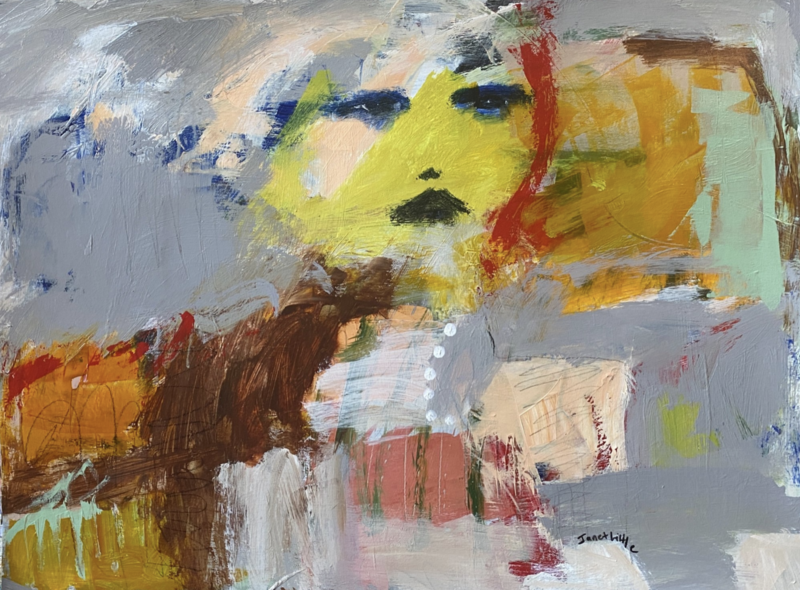
Janet Little, When All Else Fails, 18 x 24 in
Finding Her Place as a Self-Taught Artist
As with many self-taught artists, confidence didn’t always come easily. The early days for Janet Little were filled with trial, error, and self-doubt.
“Sometimes it took more time than necessary to understand certain concepts of art making,” she admits. “Imposter syndrome can be a block in believing in yourself and your art.”
That imposter syndrome—like for so many of us—crept in quietly for Little, especially when she began putting her work out into the world. At one of her first gallery shows, surrounded by realism and technique-heavy oil paintings, she felt out of place. “The first time I brought my art to the gallery to show, I was so nervous because my art was not like anything else they had there! It was raw, highly emotional, and a bit ‘out there.’”
But as she kept painting—and sought guidance from an art coach—something shifted. She began to see the power in her unfiltered techniques.
“I learned to love my style," Little explains. "And I learned that there are artists out there that would love to be able to grab a cheap chip brush and, with large, spontaneous brush strokes, make a painting. And I was doing that—making paintings without a reference, just from what my head and hand and the paint could do.”
Fight Imposter Syndrome with Structure:
Imposter syndrome thrives in chaos. But having your work documented, priced, and presented professionally can quiet that voice that says, “I’m not a real artist.” Artwork Archive gives you a way to see your progress, own your body of work, and show up like the pro you already are.
Getting Organized With Artwork Archive
As Little’s body of work expanded, so did everything else around it—exhibits, invoices, collector relationships, and tax documents. What once felt manageable began to need more structure.
“I have to say that I am not the least or the most organized person out there,” she shares. “But as I made more art, started selling, and began exhibiting in local galleries and shows, I realized I would benefit by having some kind of organization strategy.”
She stumbled upon Artwork Archive thanks to a fellow artist on Instagram, and what started as curiosity quickly became a cornerstone in her studio practice. “The functions Artwork Archive provides are so useful," Little says.
Some of her favorite features?
-
Tax Prep Support
“I’m able to log expenses and revenue for tax purposes.” -
Professional Invoicing
“I can make beautiful invoices for my collectors.” -
Exhibition & Gallery Tracking
“I can keep track of shows I have entered and galleries where my art is hanging.”
Even small things—like being able to present her work professionally through her Public Profile—make a big difference.
When asked about the feature she couldn’t go without, Little was quick to answer: “Having the ability to track expenses and revenue.”
FindYour Favorite Feature on Artwork Archive:
Not every artist needs every tool—but finding the right one can make the admin side way less painful. For Janet Little, it was tracking expenses and revenue. For you, it might be exhibition tracking, invoicing, or building a sleek Public Profile.
Explore our features and start with the one that would make your life easier, then build from there!
Her Advice for Artists Just Getting Started
Janet Little knows what it’s like to be swept up in the making of art—and to overlook the parts that feel less creative. But her advice to new artists is simple: don’t wait.
“If you can, start as soon as possible to document and log your work,” she says. “Using a platform like Artwork Archive is well worth it to decrease your admin time. Most everything you need is there!"
She speaks from experience. For years, her focus stayed on the canvas. The business side? That came a bit later—and not without its headaches.
“I did not start logging my expenses until last year," the artist admits. "When tax season came around I wasted so much time looking for receipts and documentation of expenses.”
Now, she’s not scrambling (and won't scramble again). With everything in one place, she can keep her focus where it belongs—on painting.
“Using the tracking system on Artwork Archive is a game changer for me—it saves time and helps make me more organized.”
Set Yourself Up Like a Professional (Even If You’re Just Starting Out):
Professional invoices, a clean public portfolio, and easy-to-pull records send a clear message: you take your art—and your buyers—seriously. Even if you're still building your career, tools like Artwork Archive can help you show up with confidence from day one.
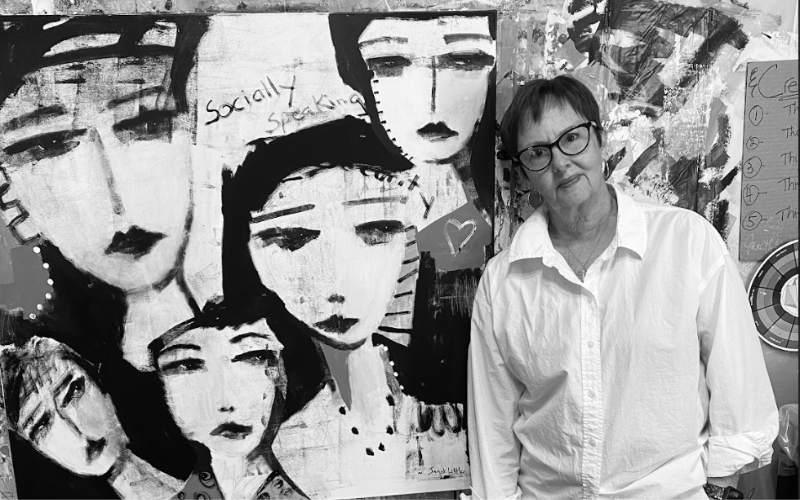
Whether you’re just starting out or years into your practice, getting started with a little organization now saves a lot of stress later—and gives you more time to focus on the work that really matters.
You can make an online portfolio, catalog your artwork, and generate reports like inventory reports, tear sheets, and invoices in seconds with Artwork Archive. Take a look at Artwork Archive's free trial and start growing your art business.





